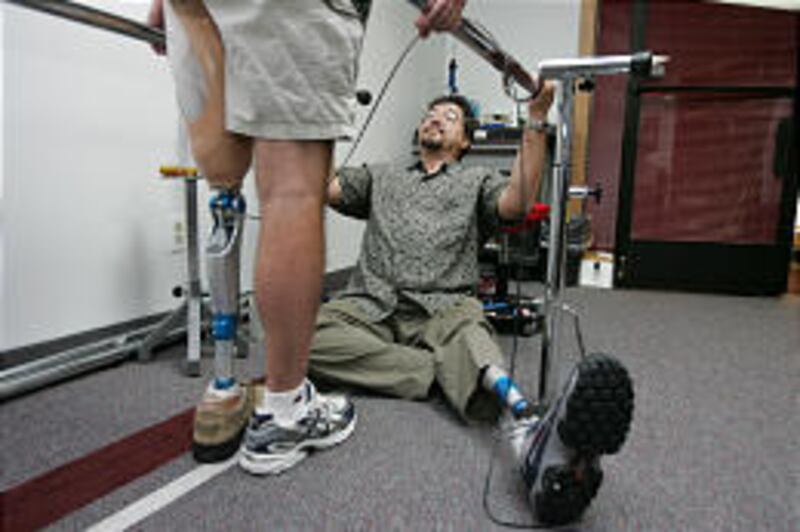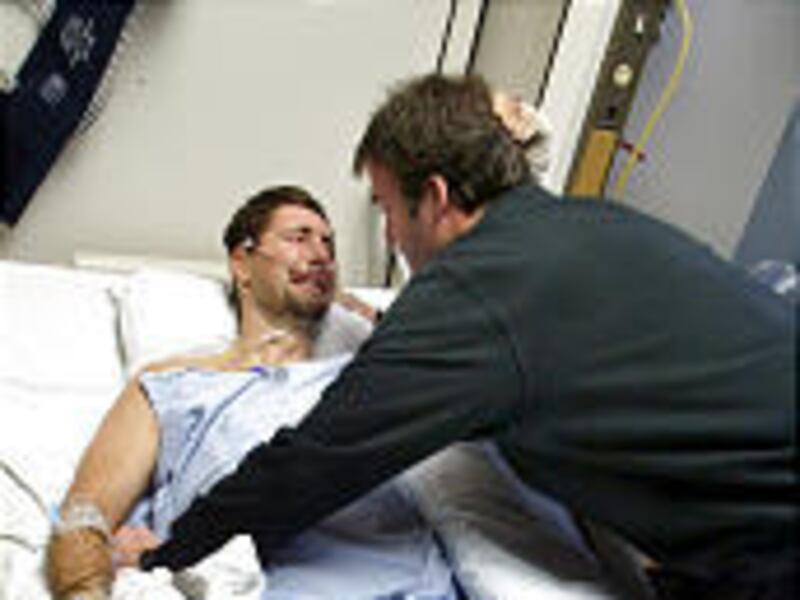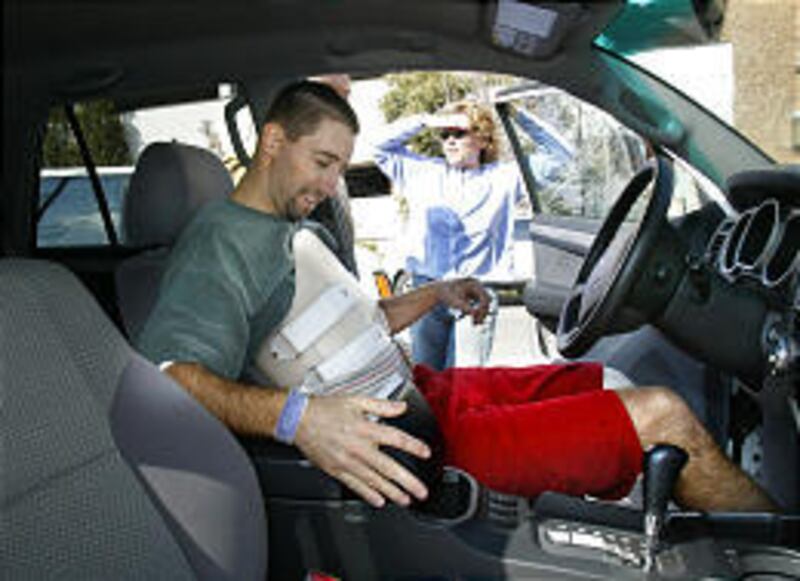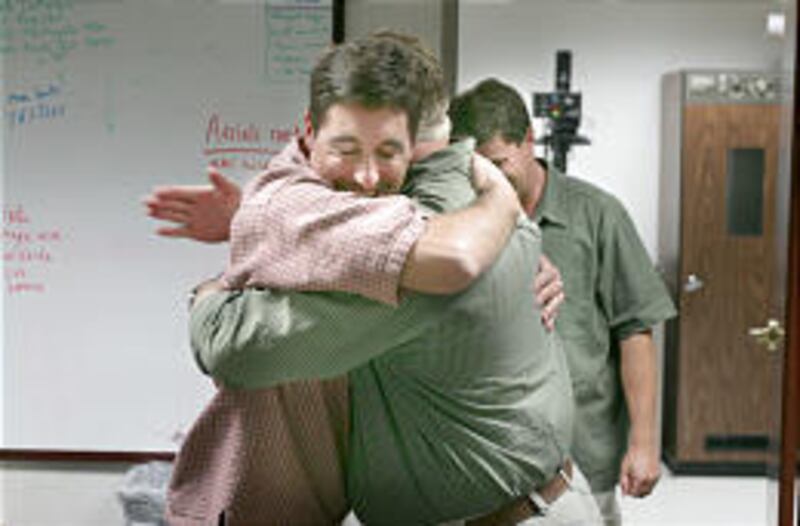His gait is more deliberate these days — put the toe down, kick the leg forward, remember to tilt the pelvis just so — but, as usual, Chuck Wing is taking everything in stride.
Six-and-a-half months after losing his leg in a freak accident on the way to get a cup of coffee, the Deseret Morning News photographer is back at work this week, as cheerful and steady as always.
Wing was injured Feb. 24 as he sauntered down Regent Street on his way to Starbucks with three other colleagues. The four friends were about two-thirds of the way down the block that morning when a Jeep Grand Cherokee trying to parallel park suddenly accelerated, pinning Wing and Gary McKellar against a wall. Seconds later, photographer Keith Johnson was dragged by the Jeep when he put it into reverse in an attempt to free his friends. A fourth News staffer, Mark Reece, was uninjured.
The road back from Regent Street, which Wing has allowed the paper to document, has included an amputation and six additional surgeries, plus months of rehab and strength training as he gets used to walking with a prosthetic leg. He's been walking on the leg since the end of July, and by now, even though he's still getting used to the mechanics of putting one foot in front of the other, the leg has become such a natural part of him that he's sometimes startled it's there.
He walked into a store recently and saw himself reflected in the glass, and for a second, he says, he was caught off guard. The man staring back looked familiar — dark hair, goatee, baseball hat, shorts — but this man had a cane and a metallic leg, as skinny as a flamingo's. Oh yeah, he said to himself, "That's me. It's the new me. That's how I am now."
Wing thinks of the accident "not as a setback at all, just a little pause." It's an attitude he learned from his parents, he says. His father has suffered from Parkinson's disease, and his mother had a radical mastectomy, and neither of them has ever complained, he says. And, too, there has been the constant support of his wife, Julie, his co-workers, neighbors, friends and strangers. Complaints, bitterness, regrets — "I don't think it was ever an option for me," he says.
Instead, he has plans. He'll do a running clinic in September, and he and Julie will go scuba diving in the Cayman Islands in October. He hopes to be riding his mountain bike in St. George this winter. All this activity is possible because he has a high-tech hydraulic leg and a "swimming leg," and soon he hopes to have a "bicycle leg." The swimming leg is a fin that attaches to the socket that covers the stump of his thigh. The bike leg will be less high-tech than his regular prosthesis but more able to withstand mud and vibration.
"People with above-knee amputations generally work twice as hard; they expend twice the amount of energy as able-bodied people in order to walk," says Joe Mahon of Ability Prosthetic Systems, who fit Wing for his new leg.
So it's crucial to beef up the quadriceps and gluteal muscles of both the remaining whole leg and remaining thigh stump and to strengthen the abdominal and back muscles that help keep the body stable enough to stand and walk.
Wing works out at the gym twice a week now with personal trainer Julian Cordova. On a recent morning Cordova made Wing do squats and bench presses until his client was grimacing and red in the face. For most of the exercises, this meant standing on the new leg, trying to find balance and stability on a piece of metal.
"The hard thing to do is to learn to trust the leg," Wing says.
The prosthesis consists of a carbon composite socket, a magnesium-coated hydraulic knee, a titanium ankle and a carbon-fiber foot. The brain of the leg is a microprocessor in the knee that is connected by a wire to the ankle, keeping the knee and ankle in a conversation at the rate of 50 messages a second. The computer chip reads what the foot is doing, where it is in space, and what kind of terrain it's on, so the walker doesn't have to constantly keep looking at the ground.
Wing's only regret is that his buddy McKellar is still sidelined, unable to join him back at work yet. McKellar, who works in the paper's new media department, also suffered a crushed leg, but doctors were able to save it. That means McKellar will eventually be able to walk on his own, but in the meantime the healing has proved slow and full of setbacks. After the bone became infected this summer, he had to go to the hospital for daily sessions in a hyperbaric chamber, and he'll have to go back in for more surgery — his eighth — in the next few weeks.
Photographer Keith Johnson, who suffered a broken ankle in the accident, returned to work in March.
Wing returns as an assistant photo editor but eventually may also shoot pictures again. Being a news photographer requires a speed and agility he hasn't mastered quite yet, but he hopes to one day again be able to shoot breaking news and sports, even to sit cross-legged on the floor at Jazz games.
He says he has no nightmares or flashbacks about the accident but says he's more aware of his surroundings now than he was before. Dropping his parents off at the airport last week, he found himself standing in front of his car wondering if the car parked in back of him might suddenly rear end him and crush him. He wasn't worried exactly, but he did move out of the way.
He's not afraid of walking down Regent Street again, either.
"I would imagine one of these days I'll take a coffee break, cane in hand," he says.
He plans to order a caramel macchiato.
E-mail: jarvik@desnews.com








